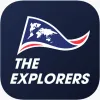Take a look inside 12 images
The Explorers
Pros: The high-quality visual content mixes science and culture, and encourages community contributions.
Cons: The content isn't well-organized or comprehensive. There aren't any resources specifically made for classrooms.
Bottom Line: The wide range of cool content is sure to fascinate students, but teachers will need to make sure that interest leads to deeper learning and research experiences.
Since The Explorers doesn't include any classroom resources, teachers will need to put in some work previewing content and building lists (using the list feature in the app) of relevant, thematic materials for their curriculum. That said: There are a ton of superb photos and videos of nature and culture from around the world, so teachers should find it easy to integrate these visuals into lessons on geography, social studies, science, biology, geology, zoology, or even architecture. The photos, videos, and stories can be used to illustrate important concepts in lessons, or as a kind of virtual field trip that introduces or extends a topic tackled in the classroom.
Additionally, The Explorers can be used directly by students, either as an open-ended exploration tool or as a source for larger research projects. Students can discover content that's interesting to them, adding it to their own personally curated lists. Students can follow each other on the app and share their discoveries. Students can also visit interesting natural or cultural areas near your classroom in order to contribute new content to the project.
The Explorers is an app and website featuring images, videos, and short stories about the earth's plants, animals, ecosystems, and cultures. The striking content -- presented in high-definition -- is created by both The Explorers team and a community of citizen scientists. The Explorers project aims to create an "Earth inventory" over a period of 12 years, showing off the diversity of our planet and how it's equally impressive and vulnerable.
The team encourages interested individuals to join the community and contribute photos and videos to the inventory, uploading their own content of nature, animals, plants, culture, and more. To make their content as discoverable as possible, community members can include metadata such as title, category, tags, location, and description. Contributors come from everywhere, so content is often in different languages, but it can be translated into English (or other languages) using the built-in Google Translate feature. Within the community, users can also connect with each other, share content, and create personally curated lists. Community content is of varying quality, but the team lists top community explorers, so it's fairly easy to find quality content.
To find content, users can browse by category (such as African Animals, or Canada); search by keyword, category, or tag; or search by location on a map, where they can zoom in and out and search in smaller areas. Each location has a title and a collection of information, such as location, description, and tags (which may be in another language as well). Other than the basic browsing and searching, it's not clear how the app is organized. There are sections entitled such things as Fast Facts, Sights to Cherish, and Trailers, but it isn't clear how the creators differentiate among them. There is one Free Movie, though, that is a longer, documentary-style video about a particular part of the world. Paid accounts can also access the Dailies (minute-long extra videos), Earth Stories (short, ~2-minute videos on something specific), and additional movies in HD/4K/8K (these are longer documentary videos about 30 to 60 minutes in length).
The Explorers provides a still-growing visual reference to natural and cultural resources on our planet. Most of the free materials don't have a lot of depth to them, but they do include brief descriptions and sometimes some voice-over work. For more well-packaged, longer documentary-quality content, you'll need a paid account.
Still, those with free accounts can make best use of this app as a resource for project research or simply open-ended exploration, or as a challenge to students to contribute meaningful material to the app's community. Students can create lists of material already in the collection that's of interest to them, and they can also share what they find and see what those they follow have discovered. Users can also earn badges -- such as Explorer, Collector, and Wildlife -- that indicate where they've contributed or used the app the most. The app's content is useful for students, but it provides only surface information or a basis to work from; depth and analysis will need to come elsewhere. Also, videos are sometimes slow to load or choppy to play, so the app may frustrate some users.





















